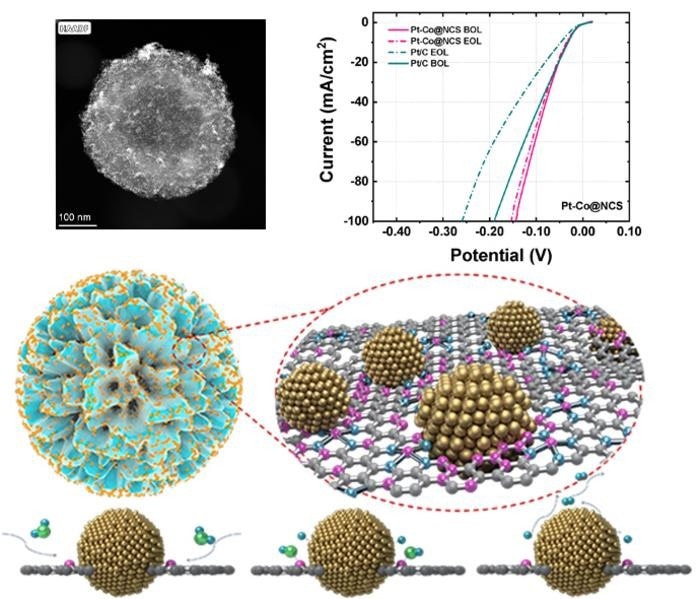A recent study published in Materials Futures described the effective synthesis of a new Pt-Co@NCS catalyst, which overcomes the traditional constraint of sluggish water dissociation.

Single-Atom and Pt Nanoparticle Multistage Synergistic Hydrogen Evolution Electrocatalyst. Image Credit: Chengyong Shu from Xi'an Jiaotong University
This study presents the Pt-Co@NCS catalyst, demonstrating remarkable synergy between Pt nanoparticles and Co single atoms on a nitrogen-doped carbon scaffold. This unique design overcomes the challenge of slow water dissociation, resulting in outstanding performance in the alkaline hydrogen evolution reaction (HER).
The Pt-Co@NCS catalyst has a current density of 162.8 mA cm–2, a Tafel slope of 26.2 mV dec–1, and a superior mass activity of 15.75 mA μg Pt–1, marking a significant advance in enhancing hydrogen evolution efficiency. These findings signal a promising future for sustainable energy alternatives.
In recent years, novel catalysts have been developed to enhance the local environment at the Pt-group interface of traditional oxide supports such as CeO2, TiO2, and SiO2. However, at high current densities, these oxide supports underperform compared to carbon supports due to restricted charge transfer and increased energy losses from internal resistance.
The demand for improved water dissociation kinetics has prompted the introduction of nanostructured, nitrogen-doped carbon supports. This method has shown a synergistic interaction with water at the faulty nitrogen-doped sites, significantly boosting HER performance.
The authors of this study developed a hierarchically porous N-doped carbon scaffold (NCS) catalyst for alkaline HER, containing Co single atoms and Pt nanoparticles. The porous structure was created by polymerizing m-phenylenediamine and etching a silicon oxide layer. Pt and Co precursors were then pyrolyzed in the confined area of NCS, resulting in small Pt nanoparticles and atomically distributed Co-N4 sites.
The exceptional performance is attributed to the catalyst’s unique porous concave shape combined with a nitrogen-rich defective surface, enhancing hydrophilicity and catalytic interaction around the Pt sites. This novel structure also minimizes the possibility of metal species aggregation, thus improving the long-term activity and stability of Pt-Co@NCS.
The synergistic interaction of Pt nanoparticles and Co single atoms, along with nanoscale geometrical factors, significantly enhances water dissociation by boosting OH– adsorption to the Co single atoms in an alkaline environment. Rigorous CO stripping and deuterium labeling tests have confirmed the enhanced water dissociation route associated with these synergistic interactions.
The study underscores the need to modify the microenvironment around catalytic sites, particularly for alkaline applications, to improve activity and stability.
The future of material development for single-atom and crystalline synergistic catalysis appears extremely promising, given the proven ability of the Pt-Co@NCS catalyst to increase HER efficiency in alkaline environments. The vast potential of high-density, atomically distributed metal catalysts on various materials is expected to be further explored in this field.
Future studies might investigate the long-term durability and scalability of these catalysts, as well as how to tailor the catalytic characteristics for other processes beyond HER, by diversifying the types of metal atoms and doping elements in the substrate.
Additionally, understanding the dynamic interactions within the catalyst microenvironment depends on developing in situ and real-time approaches for atomic-level monitoring of synergistic catalytic processes.
The catalysis community is anticipated to make significant progress in developing more cost-effective, durable, and efficient catalysts to enable sustainable energy technologies.
Journal Reference:
Shu, C., et. al. (2024) Synergistic Effect between Co Single Atoms and Pt Nanoparticles for Efficient Alkaline Hydrogen Evolution. Materials Futures. doi:10.1088/2752-5724/ad521f